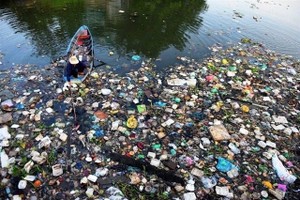 |
Ea H’leo 1 Reservoir brings various benefits to local residents in Dak Lak Province (Photo: SGGP) |
Many fields in Klah Village of Ia Mo Commune in Chu Prong District (Gia Lai Province) are golden with ripe rice. Two years ago, owing to water insufficiency, farmer Ro Mah Tuyt could only grow one crop on his 8 acres of rice field with extremely low yield. Thanks to the new irrigation system in the area, he confidently doubles his crop and can enjoy an output increase of 7 times.
Vice Chairman of the Ia Mo Commune People’s Committee Nguyen Tuan Anh informed that the water from this irrigation system helps nearly 1,000ha of rice field in the commune avoid dryness. Farmers, therefore, can grow two crops per year to raise their yield and happily get out of the poverty state. They are willing not to encroach on forest land anymore but to protect and turn their land into more prosperous one.
A similar story can be found in other areas of Chu Prong District, where the land is now more productive thanks to the 4 main irrigation systems. This greatly improves the living standards of local residents as they can now earn more money.
Meanwhile, in Dak Lak Province, Ea H’leo 1 Reservoir in Ea H’leo District, invested by the Ministry of Agriculture and Rural Development with a total amount of VND1.5 trillion (US$61.5 million), comes into operation to provide irrigation water for 5,000/78,000ha of agricultural land as well as domestic water for 15,000 local residents.
Another reservoir called Dak Long 1 in Sa Looing Commune of Ngoc Hoi District (Kon Tum Province) was put into use last year to offer irrigation water for 160ha of rubber trees, coffee crops, and rice fields of 700 nearby households.
Lam Dong Province now has 440 irrigation works, including 227 reservoirs, 90 dams, 19 water pump stations, 91 temporary dams, 12 sewage canals, and 1,200km of irrigation canals. They serve about 47,500ha of arable land by addressing water shortage and regulating rainwater. Thanks to that, the province can now develop its hi-tech agriculture easily.
In the South-Central region, Ninh Thuan Province is one of the driest. Before 1995, agricultural activities mostly happened in the north of the province around Da Nhim Hydropower Plant with a capacity of 165 million cubic meters and nearby small reservoirs. Still, water lack was rather common. When Tan My Irrigation Lake, with a capacity of 220 million cubic meters, came into operation, the province felt relieved. This is the first work in Vietnam to regulate water via closed pipeline pressure to better control water distribution.
 |
Thanks to irrigation works, Binh Thuan Province is now considered the dragon fruit capital of the country (Photo: SGGP) |
In Binh Thuan Province, to fight against drought, for the last decade, the local authorities have used both the financial aid from the Central Government and their own budget in constructing dams, canals, and small reservoirs to store water.
Residents in Ham Thuan Bac District formerly depended on rainwater for agricultural activities, so they could only grow one crop per year with extremely low yield. Since 1996, Song Quao Reservoir, with a capacity of 80 million cubic meters, has been in operation and helped to expand arable land by over 10,000ha.
Similarly, in Ham Thuan Nam District, by 1990, dwellers had struggled for domestic water use and irrigation water. With the introduction of Song Mong Reservoir (capacity of 34.17 million cubic meters), the once arid land transformed into the dragon fruit capital of the province, having a farming area of over 12,000ha.
Binh Thuan Province is now actively cooperating with related ministries, state agencies to build more irrigation works like Da Bac Reservoir (capacity of 8.94 million cubic meters), Long Song Reservoir (37 million cubic meters), Ca Giay Reservoir (nearly 37 million cubic meters), and Song Luy Reservoir (about 100 million cubic meters). They are expected to help cope with drought effectively.
The Binh Thuan Province Department of Agriculture and Rural Development informed that there are 209 irrigation works in the province, including 49 reservoirs and dams, pump stations, canals with a total capacity of more tha 442 million cubic meters. The whole length of all irrigation canals in the province is 1,800km. This allows convenient water distribution for both agricultural and domestic water uses.
























